PinotFile: 10.41 November 8, 2016
|
Identification of Pinot Noir Clone by Cluster MorphologyIn April 2016, I came across an interesting article in the online BK Wine Magazine at www.bkwine.com. Author Per Karlsson discussed how ampelographers distinguish one grape variety from another. The most reliable way to identify a grape variety or clone would be a DNA test. Grapevine cultivars have been studied extensively using genome sequencing and specific grape varieties have been singled out. For example, the Pinot Noir grape was sequenced several years ago by an Italian-based multinational consortium. Identifying specific Pinot Noir clones by DNA testing has not been reliably successful to date. Botanical specialists can use leaf and grape bunch morphology to identify grape varieties and to a lesser extent grape clones, but it is not always easy to be certain. Karlsson points out the important characteristics of grape bunches in arriving at an identification: (1) color of the bunch, (2) size and weight of the bunch, (3) size of the berries, (4) shape of the bunch, (5) tight or wide spread grapes in cluster, (6) where is cluster attached on vine, (7) thickness of grape skins, and more. Identification of clone based on grape bunch appearance is challenging because presentation will be altered by site, climate, vintage, and a number of other variables. I collected a number of different clonal and selection Pinot Noir grape cluster photos to demonstrate the similarities. Thanks to Jeff Fink, proprietor and winemaker of Aether Wines, for permission to use many of his photos from the 2015 vintage. Key (top left to right): Quinta Del Mar Vineyard Dijon 777, Quinta Del Mar Vineyard Dijon 115, Laetitia Vineyard Dijon 115, Dierberg Vineyard Mount Eden; (bottom left to right) Pence Ranch Swan, Drum Canyon West Block Calera, Drum Canyon East Block Calera, Drum Canyon Swan, Sanford & Benedict Dijon 115. Enlarged photos below follow the same sequence.
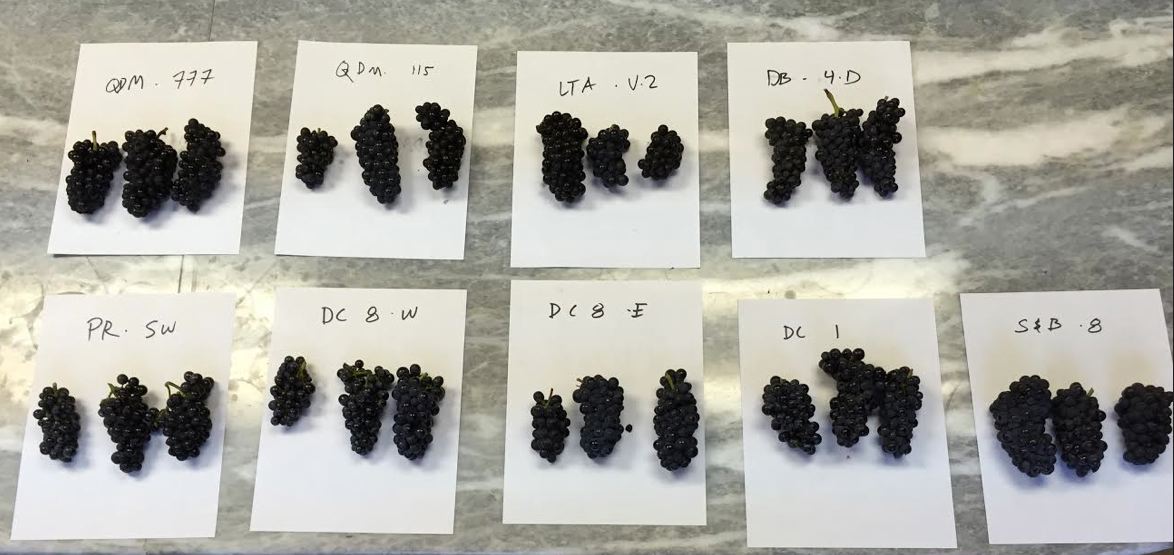
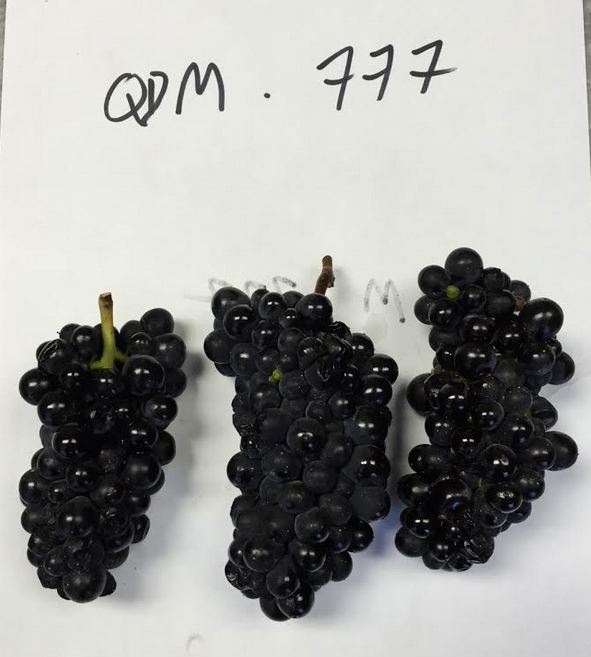
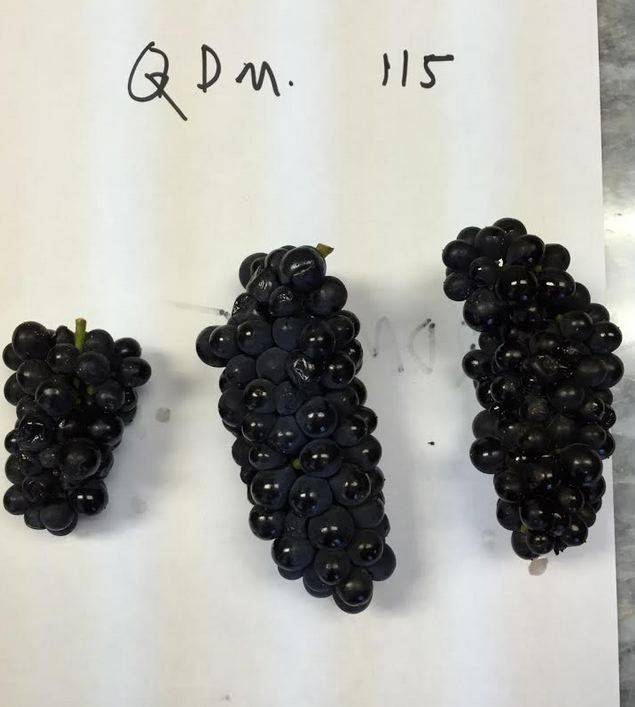
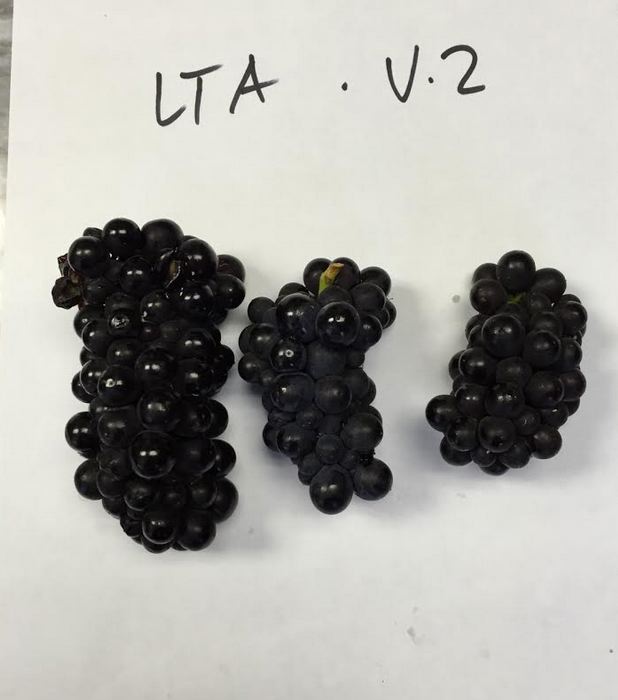
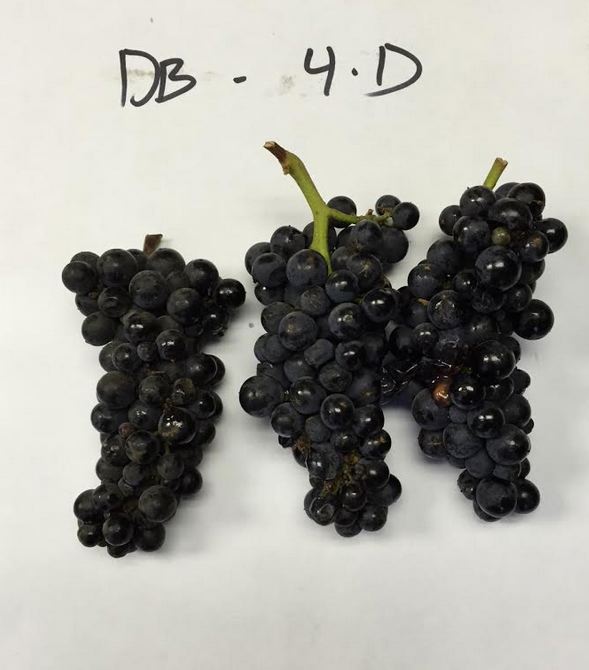
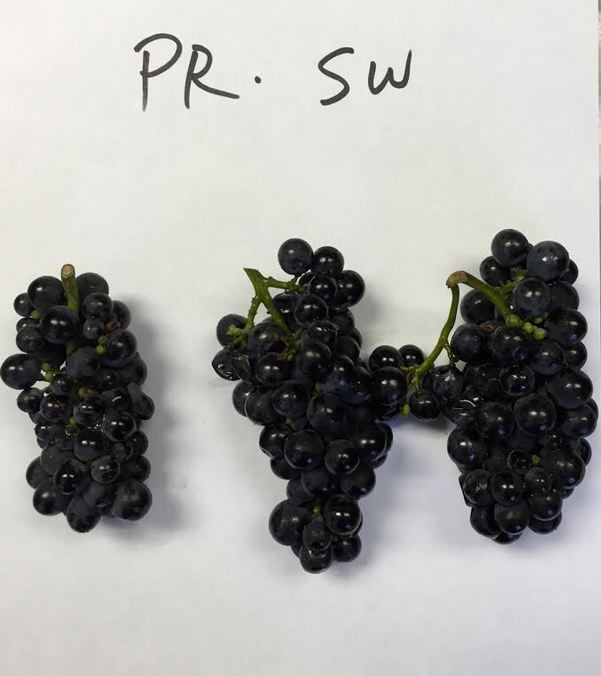
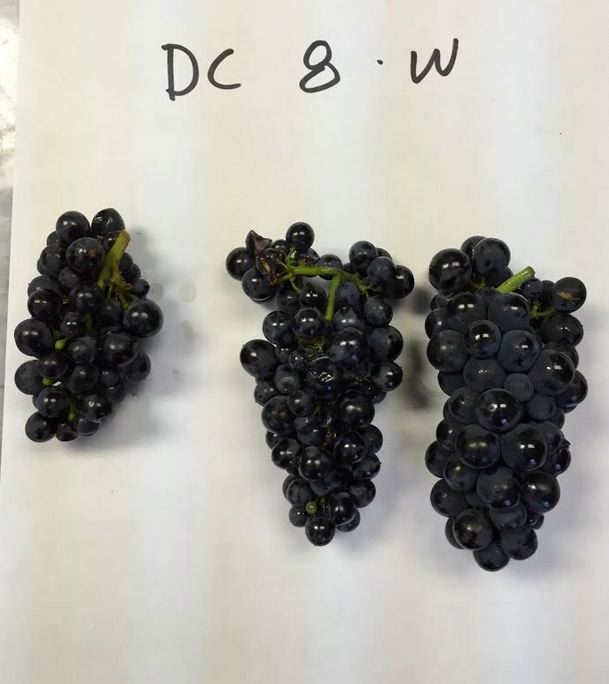
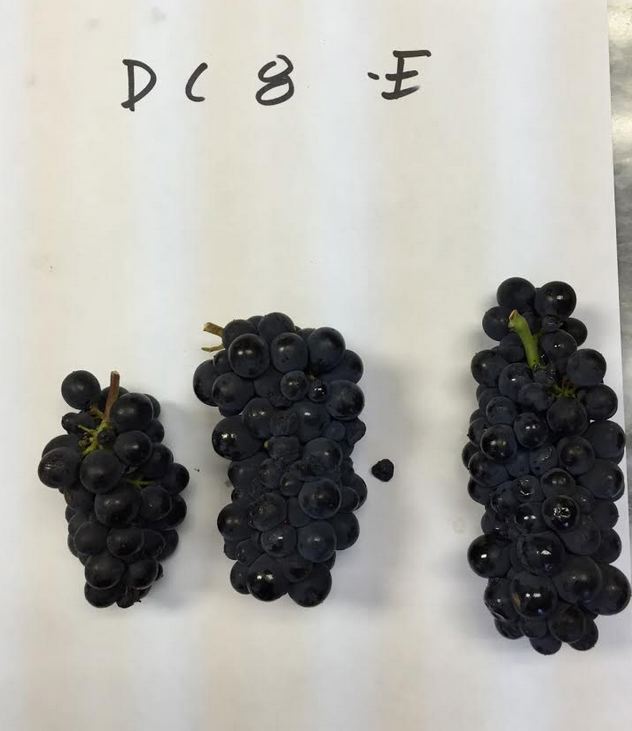
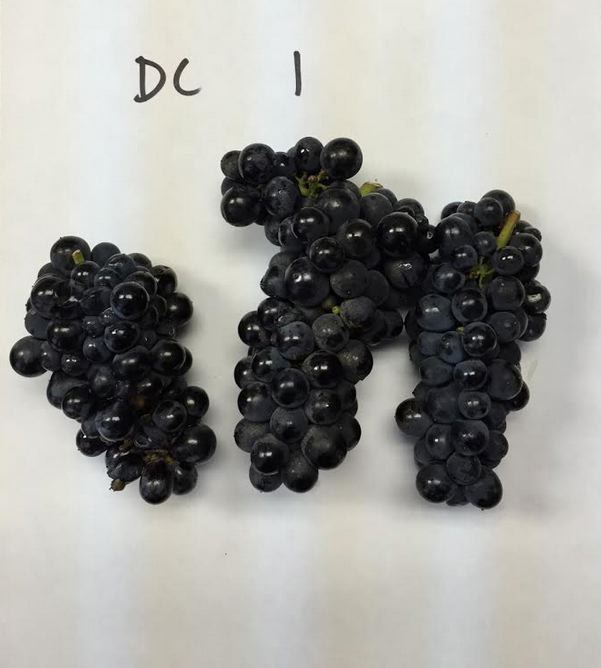
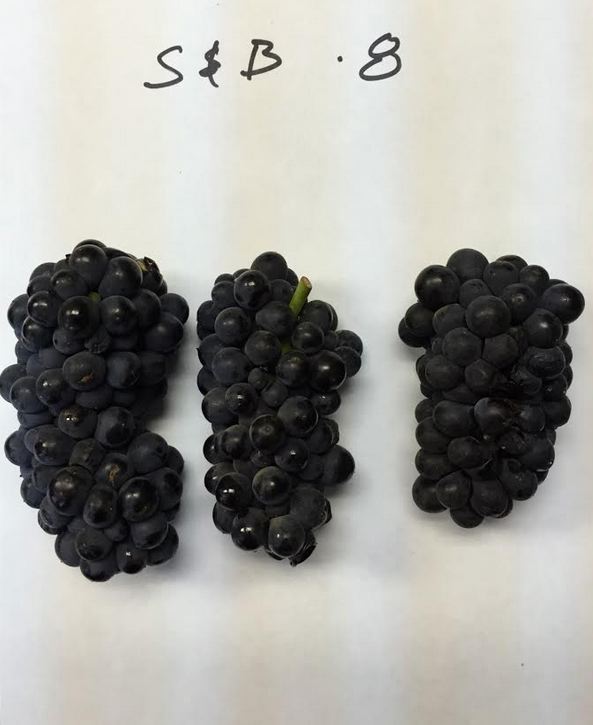 I have included this photo as well which adds cluster views of Pinot Noir clones Dijon 114, 23 (Mariafeld) and Pommard 5 to 115 for comparison. Below is a photo of Dijon 943, a very small clustered clone compared to Dijon 777.
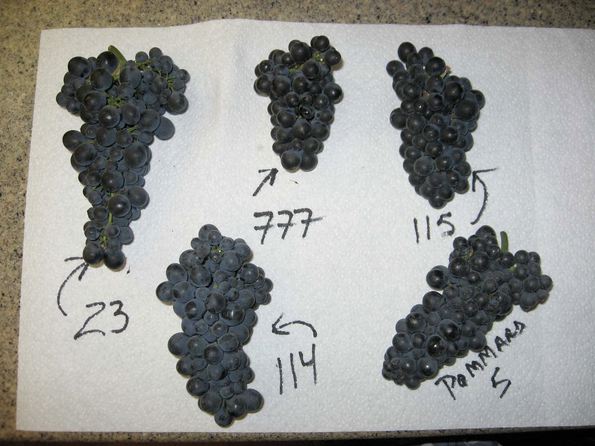
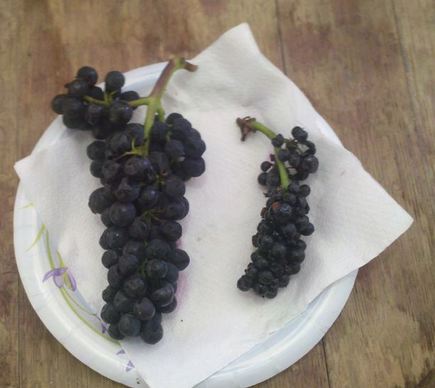
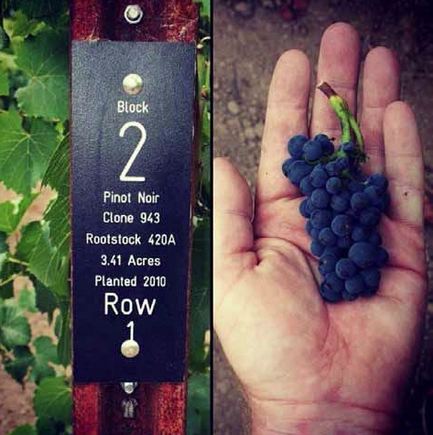
The 100-Point Scoring System has Outlived its UsefulnessThe 100-point scoring system has been the standard used by nearly all wine publications to rate wines since its introduction by Robert Parker, Jr., in 1983. Parker has said that the various 20-point rating systems do not provide enough flexibility and often result in compressed and inflated wine ratings, yet the 100-point wine rating system has become subject to the same shortcomings since it essentially has become a 20-point rating system also. Wine quality standards in the 1980s were nowhere near what they are today, especially for wines like domestic Pinot Noir, resulting in very few wines of less than 80-point quality. Your wine got a score of 90?: yawn. The virtue of domestic wines like Pinot Noir has risen to such an extent that it is rare to find a wine that rates below a score of 80 except for cheap, supermarket bottlings priced less than $12 that rarely are reviewed. In Parker’s rating system, 80 would qualify as barely above average while wines below this would be considered straightforward and innocuous. These innocuous wines that deserve scores of less than 80 are usually omitted from publications since the wines have no interest to readers of these publications. With current California and Oregon Pinot Noirs, the vast majority of bottlings over the past few vintages fall in the 87-92 point range (not only for wines I review but for wines reviewed by many other publications). In essence, this range becomes the “average,” with scores of 93 and above being outstanding or even extraordinary, and scores below 87 becoming below average. The 100-point scoring system has been compressed to a 20-point scoring system with little to differentiate the wines. The inflation of scores has diluted the value of a 90 point score and the compression of the scoring range has pushed more wines into the 95-98 range, even though they can be undeserving by past standards. I reviewed my scoring from 2013-2016 to see if there was an inflation of my scores of Pinot Noir. There was only a slight increase. I did not include reviews where a range of scores were offered (ie 90-91). The average scores for each year: 2013: 89.6, 2014: 90.4, 2015: 90.2, and 2016: 90.7. Interpretation of 100-point scoring system is not consistent. Nearly every wine critic interprets the 100-point rating system differently such that the scores are not strictly comparable from one critic to another. One of my readers, Bob Henry, has pointed out a number of inconsistencies in the 100-point scoring system as used by different publications. He notes that the Wine Spectator (March 15, 1994), a publication that adopted the 100-point scoring system in 1985, reported its editor explaining that reviewers do not assign specific values to certain wine properties of a wine when they score, preferring to grade the wine for overall quality as a professor grades an essay taste. A score is then based on how much the reviewers like the wine overall. No specific points are assigned to color, aroma, texture, finish and so forth as Parker does. I would say the essay analogy is flawed since professors look for specific grammar and syntax errors and subtract these errors in determining the final grade. Parker has maintained (Wine Times, 1989) that his rating system is really a 50 point system that incorporates two 20-point systems with a 10-point cushion on top for wines that have age ability. He gives up to 5 points on color, up to 15 points on aroma, and up to 20 points on flavor, harmony and length. That equals a possible 40 points. The balance of 10 points is awarded to wines that have can improve in the bottle (admittedly sort of arbitrary). I do not assign specific points to wine qualities but rather take into account aroma, flavor, texture, length of finish and balance. Beyond this, there is a subjective factor that equates to emotion: some wines remote or excite. I also rate primarily on how the wine drinks at the time of review and give only a little credit to age ability since I know most readers drink their domestic Pinot Noir and Chardonnay within a few years of release. I do re-taste many better wines after opening later in the day or the following day as a determination of quality and long term aging potential, and take this into account. My scoring system for Pinot Noir and Chardonnay has been: 94-100 (extraordinary deserving of the Pinot Geek icon), 90-93 (outstanding), 86-89 (very good), 80-85 (good) and 75-79 (decent). Scores have not been published for wines that are unsatisfactory or score less than 80 points since I cannot recommend them. Bob Henry pointed out to me the 100-point scoring system discrepancies among different reviewers with another example. The Pinot Report 100-point rating scale considered a score of 80-85 as average because the quality of winemaking in California has improved insofar as recalibration of the “average” quality made necessary a change from 70 to 85 points for an “average” quality wine. Highly respected wine critic, Jamie Goode, recently commented on his scoring of wines in his blog, Wineanorakat www.wineanorak.com/wineblog/. A reader had pointed out to Jamie, “He basically operated in the range of 85-95 (theoretically 100 as upper limit), with most scores around the 90s give or take 1-2 points. This is bordering on the useless for the readers...with the advice less-than-useful.” Jamie responded, “Yes, my scores fall within a narrow range for this blog. There are many wines I rate far lower but they never make it here or into my online write-ups. A false positive is better than a false negative. If I give a wine a low score and I’ve got it wrong, it could harm someone’s business. So I would rather not say anything about wines if I don’t like them. I also need to say that the 100 point scale is very compressed at the top end....and this scale is becoming so bunched at the top end that it is nearing the end of its useful life. I simply can’t start using my own scale unilaterally. It would be daft.” Jamie’s dilemma is also mine. The 100-point scoring system is so compressed around 90 points, useful distinctions are challenging to arrive at and measurable differences between a rating of say 89 and 90 are vague. I have a number of misgivings about the 100-point scoring system, and did not rate wines with a numerical score during the first six years of publication of the PinotFile. In reality, a wine score only matters to the person doing the scoring since we all have different tastes. That said, the wine drinking public has come to rely more on scores than wine descriptions in choosing wines and have learned to align themselves with wine critics whose palate closely follows their own preferences. What next? So what to do with a wine rating system that may have outlived its usefulness and is of declining interest to the up and coming younger generation wine consumer? How can we devise a new rating system that won’t invalidate, discredit or deem useless the 30+ years of published ratings based on the 100-point system? Earlier this year, a former Lazard investment banker launched a data-based wine rating system based on 1000 points known as Wine-Lister. Wine-Lister points out that the 100-point ranking is narrow, with just about all scores ranging from 80 to 100 points. The system takes into account a wine’s estimated age ability, its price, its auction performance, and global strength of the brand. Much of this data would have no applicability to domestic wines except the most highly collectible. The 100-point and 20-point ratings of wines by prominent critics are translated into the 1,000 point system. Wine-Lister would seem to appeal only to serious collectors and investment-worthy wines. Visit www.Wine-Lister.com. I have often considered the usefulness of a taxonomy of Pinot Noir that could be applied to the tasting notes of different reviewers so that the reader could compare the notes. A 100-point score quality judgment could be incorporated at the end, but would receive less emphasis. As ratings stand now, the only facts in tasting notes that are truly comparable are objective data such as vineyard information, production information, harvest Brix, final ABV, pH and TA. The subjective portion of the review including its presentation format is widely variable and as emphasized here, numerical scores are not strictly comparable either. As an example, here are two reviews of the 2009 Hirsch West Ridge Sonoma Coast Pinot Noir by two different publications.
Wine & Spirits A barrel selection from three blocks along the main ridge of David Hirsch’s far-coast vineyard, this comes from 6A, 6E and 7, planted to Mount Eden and Swan, as well as clone 114 from Dijon. It’s quieter than you might expect from the New World, clocking in at 12.9 percent alcohol with a light, transparent ruby color, but the persistence of flavor reveals its inner strength. What at first seems spice and vegetal turns cool and exotic, in the tart cranberry range of the flavor spectrum, but more complex than that would imply. Spend some time with this wine, now or ten years from now, and you will be amply rewarded. 94, $85, 127 cases, Hirsch Vineyards, Cazadero, CA.
PinotFile 12.9% alc., pH 3.48, TA 0.67, 127 cases, $85. A limited production bottling from three exceptional hilltop blocks on the West Ridge of the Hirsch Vineyard covering 28 acres and divided into 27 farming blocks. This bottling is a selection of the most exceptional barrels from these blocks. The wine is dominated by Mount Eden clone with a dash of Swan clone. Aged 17 months in 35% new French oak barrels. Moderate reddish purple color in the glass. Exotically fruited, with a panoply of fresh, dark berry aromas underlain with scents of oak and underbrush. The pleasing core of dark berry and plum fruit is wrapped in moderate tannins and offers a citric peel acidity in the background. The wine develops more vivacious fruit over time in the glass indicating that cellaring is warranted. Very good.
My proposed standard review format. The two reviews provide much of the same important information but the presentation is dissimilar and the facts and impressions are offered in a different sequence. Suppose the following format was used by both reviewers? The words in italics are for subjective assessment and are only suggestions that all reviewers could use by picking one option for consistency. These are only possibilities and would have to be refined, but you get the idea. Not all dates were available for this wine so they are not entered.
Wine: 2009 Hirsch West Ridge Sonoma Coast Pinot Noir
I would be curious to know the thoughts of readers on the current use of the 100-point scoring system and any recommended alternatives. Do you read the wine description or do you use the score as your main guide? All appropriate responses will be published in the PinotFile. Please respond to prince@princeofpinot.com.
Soliste Pinot Noir: Fanatical Devotion Shows in the Superb WinesPartners Don Plumley and Claude Koeberle launched Soliste MonoClone® wines with the 2009 vintage, returning California Pinot Noir to its roots in Burgundy and the craftsmanship of the Cistercian monks of Vougeot, focusing on Sonoma Coast Pinot Noir: wines produced from single clones, single vineyards, and matured in single cooperage. The winery’s limited production Pinot Noirs reflect a fanatical commitment to harness the purity and complexity of one clone from a single vineyard. You won’t find scores for Soliste wines in the major wine publications. The wines are darlings of sommeliers throughout the United States and are offered on wine lists of many highly regarded and Michelin-starred restaurants (visit the website for a listing of restaurant partners). They are produced in tiny quantities and sold only through an allocated mailing list. If you are a lover of Pinot Noir and have the wallet to match, these wines are required acquisitions. Soliste Pinot Noir is one of the few that I buy personally for my cellar. The following extraordinary wines were part of the 2016 fall release of Soliste wines. Soliste began modestly with the release of 143 cases of Pinot Noir from the Sonatera Vineyard in 2005. In 2009, the proprietors challenged themselves to make Pinot Noir from a single vineyard, single clone and allocate a single cooperage barrel house in France to deliver focus without compromise to each wine. The MonoClone® designation was trademarked, but Don and Claude were not infatuated with the idea because the wines had to deliver. If they did not, they would have gone back to blending the clones. The MonoClone® wines have turned out to be spectacular. The three wines offered here were the result of an ideal growing season for Pinot Noir. Since 2005, Soliste has dealt with drought, fires, rain at the wrong time when it finally came, heat spikes days before harvest, red blotch, years with minuscule yields, to name a few challenges. When 20013 arrived, it seemed the weather was finally cooperative and as Claude put it, “Darth Vader did not show up.” Typically, L’Espérance is the most feminine and ethereal Pinot Noir that Soliste produces and L’Ambroisie is the most masculine and enigmatic and that difference is reflected in the wines in this vintage. At a time when most wineries are releasing their 2014 vintage Pinot Noirs and even 2015 vintage Pinot Noirs, Soliste has released 2013 vintage wines that have clearly benefitted from the additional time in bottle. Pinot Noir is all about aromatics, texture and refinement, and these wines are blessed with all three.
2013 Soliste L’Espérance Sonoma Coast Pinot Noir 13.3% alc., pH 3.66, TA 0.59, 123 cases, $85. Sourced from Sonatera Vineyard in Sebastopol, with vines planted in Goldridge sandy loam. Dijon 115. 0% whole cluster. Aged 16 months in French oak barrels, 20% new. · The most Chambolle Musigny in style with an ephemeral quality that seduces the drinker. Moderately light reddish purple color in the glass. I thought sure this wine had whole cluster inclusion based on its savory components. Rapturous aromas of black cherry, raspberry, spice, rose petal and cigar. Velvety in the mouth, with a well-spiced black cherry core that is highly expressive. Lightest in weight of the three Pinot Noirs tasted today, but not light in flavor. Floral and toasty oak notes add interest. The delicate tannins make for an elegant impression. When tasted the following day from a previously opened and re-corked bottle, the wine was aromatically intoxicating and the spiced fruit core continued its exuberance. Tres Pinot. Score: 94
2013 Soliste Renaissance Sonoma Coast Pinot Noir 13.2% alc., pH 3.50, TA 0.67, 147 cases, $85. Sourced from a special few rows of Sonatera Vineyard. Dijon 777. 50% whole cluster. Aged 16 months in French oak barrels, 25% new. · Moderate reddish purple color in the glass. Deep aromas of fresh black cherry reduction sauce, sous-bois, and dark red rose petals. An “Oh Man!” nose. The mid weight flavors of cherry and raspberry combined with more subtle floral and spice notes tug at your taste buds. Silky in the mouth, with soft, fine-grain tannins and a bombastic cherry-fueled finish. When tasted the following day from a previously opened and re-corked bottle, the nose almost brought me to my knees. Harmony personified. Score: 95
2013 Soliste L’Ambroisie Sonoma Coast Pinot Noir 12.9% alc., pH 3.55, TA 0.56, 49 cases, $100. Sourced from the secluded Guidici Vineyard surrounded by redwoods in the Sonoma Coast AVA near Occidental, only 6 miles from the Pacific Ocean. Dijon “828.” 20% whole cluster, Aged 16 months in French oak barrels, 0% new. Moderately dark reddish purple color in the glass. · The most intensely fruity and darkest fruited nose of the three Pinot Noirs tasted here. Black raspberry, blackberry fruits are complimented by an assortment of spices including nutmeg. Impressive attack of bold black raspberry, black cherry and spice flavors that find every crevice in the mouth, but an even more impressive finish that dances on for minutes. Impeccable balance, with a silk and satin texture, and inviting acid backbone. When tasted the following day from a previously opened and re-corked bottle, this wine was charming, sexy and loquacious with considerable nuance and a harmonious personality. I was taken by this wine not so much for its sappy fruit, but its complexity and finish. Score: 96
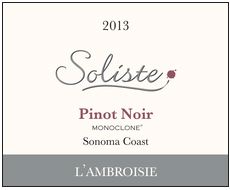 You may be able to secure an allocation at www.soliste.com or contact Don at don@soliste.com. Still to come from the 2013 vintage: 2013 Soliste Solitaire Sonoma Coast Pinot Noir (clone 23, 100% whole cluster), 2013 Soliste Les Griottes Sonoma Coast Pinot Noir (clone “828,”), 2013 Soliste Nouveau Monde Sonoma Coast Pinot Noir (Pommard clone), and 2013 Soliste Forêt Sonoma Coast Pinot Noir (clone 23).
Recently Tasted Pinot Noir
FEL, Sonoma
2014 FEL Savoy Estate Vineyard Anderson Valley Pinot Noir 14.3% alc., $70. Planted by Richard Savoy in 1991, the 44-acre vineyard is located just west of the town of Philo. Dijon and heritage clones of Pinot Noir. · Moderate reddish purple color in the glass. Aromas of cherry pie, blackberry preserves and spice are attention getting. Luscious and saucy, with mid weight flavors of black cherry and blackberry complimented by oak seasoning in the background. Silk and satin in the mouth, with admirable vibrancy, slightly astringent tannins, and a charge of fruit on the lengthy finish. Score: 92
Frank Family Vineyards, Calistoga
2014 Frank Family Vineyards Carneros Pinot Noir 14.5% alc., pH 3.63, TA 0.59, 5,000 cases, $35. Aged 10 months in French oak barrels, 33% new and 67% once and twice-filled. · Moderate reddish purple color in the glass. Lovely aromas of black cherry liquor, spice and potpourri. Silky in the mouth with immersed tannins, offering highly enjoyable flavors of black cherry, ripe strawberry and boysenberry. Forward drinking with intense cherry goodness on the back end. When tasted later in the day from a previously opened and re-corked bottle, the allure of vivid cherry and spice flavors sent me for a second glass. I prefer this wine over the Reserve. Score: 93
2014 Frank Family Vineyards Lewis Vineyard Reserve Napa Carneros Pinot Noir 14.5% alc., pH 3.55, TA 0.60, 1,000 cases, $65. Lewis Vineyard is located near the shores of San Pablo Bay. Bought by Rich Frank in 2000 and named for Paul Frank’s son, Lewis, this 68-acre vineyard has 10 acres planted to Pinot Noir. Soils are primarily shallow, dense clay loam and rainfall is limited to 20 inches annually resulting in very low yields. Aged 10 months in French oak barrels, 50% new and 50% once-filled. · Moderately dark reddish purple color in the glass. A big boy, hedonistic wine with a plethora of blackberry, cassis and oak vanillin aromas and flavors. The tannins and acidity keep the fruit corralled, such that the wine is relatively light on its feet. Totally different from the regular bottling and well done in this generously oaked reserve style Pinot Noir. Score: 91
Kingston Family VineyardsThis is a boutique winery located on the ranch in Casablanca, Chile, that has been in the same family for a century. Kingston Family Vineyards is one of only a handful of Chilean vineyards leveraging artisan winemaking and sustainable viticultural techniques to produce cool climate Pinot Noir, Syrah, Sauvignon Blanc and Chardonnay from estate vineyards. The Kingston vineyards now consist of about 350 acres in a valley that is similar to California’s Central Coast, but somewhat colder. The vineyards lie about 12 miles from the Pacific Ocean surrounded by rolling forested hills. The climate is mild and the growing season is long. All vines are planted on their own roots with the 80 acres of Pinot Noir planted in the hills where sun exposure and drainage is more favorable and the soil contains considerable decomposed granite. Dijon clone 777 is planted along with two field selections known as Valdivieso, a shot berry clone similar to Swan that makes the top Alazan blend, and Conca y Toro, a small-clustered clone. The Chilean winemaker is Amael Orrego and the North American consulting winemaker is Byron Kosuge. Kosuge has specialized in Pinot Noir for over 25 years. Pinot Noir vinification is traditional and includes a 5+ day cold soak, mostly native yeast ferments in 1-ton and 3-to-5-ton open top tanks, with pump overs and punch downs as needed. Press wine is separated, and the wines undergo malolactic fermentation in barrel using indigenous bacteria. The wines are aged only in French oak barrels with roughly 15% to 30% new barrels for 10 months. The wines are not racked until the blends are assembled just before bottling right before the next harvest. 2015 was an unusually warm vintage for Kingston. The wines are available for shipment to US markets and consumers. As an added bonus, the wines represent excellent value. Visit www.kingstonvineyards.com.
2015 Kingston Family Vineyards Tobiano Casablanca Chile Pinot Noir 14.0% alc., 275 cases, $22. A blend of barrels that don’t make the top tier. This is not a lesser wine, but one that is lighter in body and a touch less complexity. · Moderate reddish purple color in the glass. A fruit-forward wine with aromas of black cherry, strawberry and oak. Silky and highly approachable, driven by cherry and red berry flavors overlaid with savory oak. The lightest and most elegant of the three 201 Kingston Pinot Noirs tasted, yet the wine delivers plenty of personality and a pleasing cherry-fueled finish. Score: 91
2015 Kingston Family Vineyards Alazan Casablanca Chile Pinot Noir 14.0% alc., 150 cases, $36. Released October 2016. Named after Peter Kingston’s burgundy-colored horse in the 1950s. A limited, reserve bottling. Less new French oak and some larger barrels were used in this vintage. · Moderate reddish purple color in the glass. A very young wine with oak expression exceeding the fruit initially. Over time, aromas of dark fruits and tobacco emerge. The gloriously sappy core envelopes the palate with an array of sweet purple and black fruit flavors with indulgent earth and oak flavors as well. Full-bodied, with balanced tannins and a fruit-filled finish. When tasted the following day from a previously opened and re-corked bottle, the showy oak had receded and the wine was more appealing. Best to give this wine more time in bottle. Score: 92-93
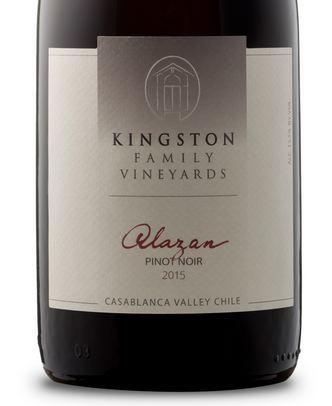
2015 Kingston Family Vineyards CJ’s Barrel Casablanca Chile Pinot Noir 14.0% alc., 75 cases, $44. A very limited production wine that was aged in 100% neutral oak. · Moderate reddish purple color in the glass. Aromas of boysenberry, blackberry, spice and tobacco lead to a mid weight plus styled wine with a copious charge of dark purple and black fruits. Refined and uplifting with good tannic bones and admirable balance. The oak is surprisingly expressive considering that neutral oak barrels were used. This wine should benefit from more time in bottle. Score: 90-91
LaRue Wines, SonomaSince 2009, winemaker Katy Wilson has offered excellent small lot bottlings of Pinot Noir from the Sonoma Coast. Her talent is exemplified by her consulting position for several wineries including Anaba Wines, Banshee Wines, Claypool Cellars, Reeve Wines and Smith Story Wine cellars. LaRue Pinot Noir and Chardonnay is sold through an allocated mailing list at www.laruewines.com. Production is 500 cases maximum.
2014 La Rue Sonoma Coast Pinot Noir 13.0% alc., 180 cases, $60. Aged 20 months in French oak barrels, 30% new. · Moderate reddish purple color in the glass. Crisp and refreshing, with bright aromas of black cherry and exotic spices replicated on the palate with added nuances of earth, mushroom and umami. Exquisitely balanced, this wine speaks of nobility and finishes with an infusion of vibrancy. Still engaging the following day from a previously opened and re-corked bottle. You won’t find a better Sonoma Coast AVA bottling in the marketplace. Score: 92
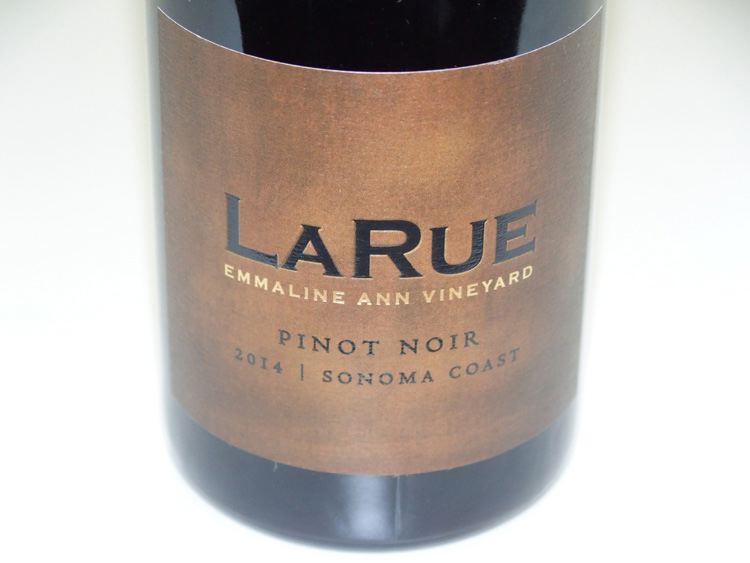 2014 LaRue Emmaline Ann Vineyard Sonoma Coast Pinot Noir 12.5% alc., 70 cases, $70. Aged 20 months in French oak barrels, 33% new. · Moderate reddish purple color in the glass. Intriguing aromas of darker fruits, almond paste and spices. Plenty of black cherry sap is buffered by savory herbs and spice. The wine has a sexy vibe and a positive message with a welcome lift on the finish. Oak chimes in currently with a little too much voice as a dried leaf flavor, but this should ameliorate with more time in bottle and will appeal to those who relish savory input in Pinot Noir. Score: 93
Loring Wine Company, LompocThe appellation Pinot Noirs, and vineyard designated Pinot Noirs from Santa Lucia Highlands and Green Valley of Russian River Valley were released in September 2016. The remainder of the vineyard designated Pinot Noirs will be released in February of 2017. These are very young wines with the aromatics of several wines in hiding at present and undoubtedly will be more accessible and deserve higher scores after another year in bottle. I did re-taste several bottles 24 hours later from a previously opened and re-corked bottle, but there were not any significant changes. There is not much to distinguish the appellation wines from each other. Most of the single vineyard wines are clearly the most classy offerings.
2015 Loring Wine Company Russian River Valley Pinot Noir 14.5% alc., pH 3.60, 300 cases, $39, screwcap. · Moderate reddish purple color in the glass. Aromas and flavors of black cherry, blackberry and marzipan with noticeable mid palate presence and some finishing power and length. The wine finishes on a soprano note with a sweet and sour profile. Lacks Russian River Valley character. Score: 86
2015 Loring Wine Company Santa Lucia Highlands Pinot Noir 14.4% alc., pH 3.61, 400 cases, $39, screwcap. · Moderately dark reddish purple color in the glass. Pleasant aromas of dark cherry and marzipan lead to a discreetly concentrated core of boysenberry and blackberry flavors. The tannins are well-integrated, the acidity has a spryness, but the wine finishes on a tart, sweet and sour note. Score: 86
2015 Loring Wine Company Sta. Rita Hills Pinot Noir 14.4% alc., pH 3.65, 600 cases, $39, screwcap. · Moderately dark reddish purple color in the glass. The nose is very primary, with only demure aromas of purple grape and oak. The mid weight core is filled with boysenberry and purple grape fruits framed by woody tones. Tannins show up on the tangy, modest finish. Score: 87
2015 Loring Wine Company Rancho La Viña Vineyard Sta. Rita Hills Pinot Noir 14.6% alc., pH 3.75, 300 cases, $54, screwcap. · Moderately dark reddish purple color in the glass. The nose is rather primary, with delicate aromas of raisin, black fruits and marzipan. The fruit pushes the ripeness envelope, veering to a roasted character omnipresent in this mid weight plus styled wine that is fruit-driven and lacking nuance. A thread of nutty oak plies the background, the tannins are well integrated, and the finish is of modest length. I found the wine still too ripe flavored for my liking the following day when tasted from a previously opened and re-corked bottle. Score: 86
2015 Loring Wine Company Keefer Ranch Vineyard Green Valley of Russian River Valley Pinot Noir 14.3% alc., pH 3.60, 500 cases, $54, screwcap. · Moderate reddish purple color in the glass. The nose offers aromas of earth, forest floor, and marzipan. The fruit flavors of black raspberry, black currant, blackberry compete with oak-driven flavors of anise, spice, tobacco and nuts. The tannins and acidity are in harmony and the satiny texture is welcome, but this wine has a tart, lemony finish, and lacks the Keefer Ranch signature. It could be from anywhere. Score: 87
2015 Loring Wine Company Rosella’s Vineyard Santa Lucia Highlands Pinot Noir 14.3% alc., pH 3.62, 300 cases, $54, screwcap. · Moderate reddish purple color in the glass. The nose is quite primary, with faint aromas of cherry, spice and nutty oak. A husky version of Rosella’s with a sappy charge of black raspberry and blackberry fruits framed by filigree tannins. Oak plays a supportive role, ample acidity energizes the palate, and there is good length on the finish. Score: 89
2015 Loring Wine Company Sierra Mar Vineyard Santa Lucia Highlands Pinot Noir 14.5% alc., pH 3.51, 150 cases, $54, screwcap. · Moderate reddish purple color in the glass. Shy aromas of black cherry, bark and spice lead off. In the mouth, the core of blackberry, cassis and spice flavors are very satisfying. There is a deft touch of oak, balanced tannins and overall harmony and poise. When tasted the following day from a previously opened and re-corked bottle, the nose had still not come to the fore. More time in bottle will undoubtedly rectify this. Score: 90-91
2015 Loring Wine Company Garys’ Vineyard Santa Lucia Highlands Pinot Noir 14.3% alc., pH 3.59, 150 cases, $54, screwcap. · Moderate reddish purple color in the glass. The nose is endowed with aromas of blueberry, black raspberry and a hint of nutty oak. Rich entry of black cherry, blueberry and black raspberry fruits, rich middle, and a rich finish. There is deft integration of oak and tannin on the palate, and the finish offers pleasing spiced cherry goodness and some length along with the richness. A trace of alcoholic warmth shows up on the back end as the wine warms in the glass. Score: 90
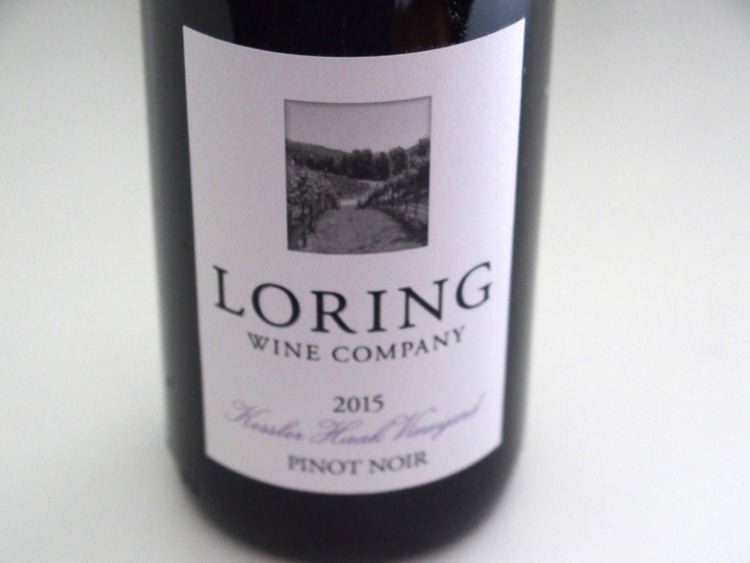 2015 Loring Wine Company Kessler-Haak Vineyard Sta. Rita Hills Pinot Noir 14.2% alc., pH 3.61, 300 cases, $54, screwcap. · Moderately dark reddish purple hue in the glass. The nose is quite fruity, offering aromas of black cherry and blueberry-pomegranate. Delicious mid weight plus blueberry, blackberry, black raspberry, plum and spice flavors that are intense and energetic. A sublime wine with enviable balance, submerged tannins, and a rich, sappy follow through to a boisterous finish. Score: 93
2015 Loring Wine Company Clos Pepe Vineyard Sta. Rita Hills Pinot Noir 14.8% alc., pH 3.56, 150 cases, $54, screwcap. · Moderately light reddish purple color in the glass. Aromas of black cherry, spice rub, potpourri and nutty oak give way in the mouth to a heady core of black cherry fruit that is framed by nutty oak. The velvety texture is quite seductive and the overall balance is commendable. Drinks well now but balance predicts good age ability. Score: 92
Peake Ranch, BuelltonThe first time I have tasted wines from this producer located in the Sta. Rita Hills. The owner is John Wagner, who owns John Sebastiano Vineyard and a part of Sierra Madre Vineyard. Doug Circle owns Sierra Madre Vineyard and trademark. Winemaker Paul Lato crafts the wines. www.peakeranch.com.
2014 Peake Ranch Sta. Rita Hills Pinot Noir 14.3% alc., 273 cases, $40. · Moderate reddish purple color in the glass. The nose is replete with black cherry fruit aroma accented with earthy mushroom and petrol notes. Easy to drink, with a slinky texture, and mid weight flavors of dark red and purple fruits highlighted with spice. Nicely balanced with some charm and a dry finish of modest length. Score: 88
2014 Peake Ranch John Sebastiano Vineyard Sta. Rita Hills Pinot Noir 14.3% alc., 245 cases, $65. · Moderate reddish purple color in the glass. Boysenberry fruit aromas are joined by scents of oak spice and woody stem. The middleweight core of juicy boysenberry and blackberry fruit is enticing and nicely spiced but a savory woody thread shadows the fruit. Silky and refined, with commendable balance and a juicy, quenching finish. Score: 89
Siduri, Santa Rosa
2015 Siduri Willamette Valley Oregon Pinot Noir 14.3% alc.,pH 3.62, TA 0.61, 14,058 cases, $27, screwcap. Released October 16, 2016. A warmer vintage with forward drinking wines. A blend of fruit from multiple vineyards. · Moderately dark reddish purple color in the glass. A complex nose leads off with aromas of blackberry, cassis, wine cave, floral notes and a hint of baked apple. Wellendowed with ripened purple and black berry fruits. Robust, yet vibrant, with matched tannins, complimentary barrel accents, and a modest sweet-fruited finish. This wine could easily be mistaken as one from California. Score: 89
2014 Siduri Chehalem Mountains Oregon Pinot Noir 14.2% alc., pH 3.53, TA 0.62, 852 cases, $35, screwcap. Released October 16, 2016. A blend of Hawks View, Muirfield and Shaw Mountain Vineyards. Clones 667, 777 and Wädenswil, both rootstock and own-rooted vines. · Moderate reddish purple color in the glass. Aromas of cherry, underbrush and oak develop over time in the glass. More expressive on the palate, with modest flavors of boysenberry and Hoison sauce. Simple and pleasant, with matched tannins and a juicy, fruit-driven finish. Score: 87
2014 Siduri Muirfield Vineyard Willamette Valley Oregon Pinot Noir 14.2% alc., pH 3.54, TA 0.60, 143 cases, $50, screwcap. Released October 16, 2016. Clones 113, 114, 115 and Wädenswil, own-rooted vines. · Moderately light reddish purple color in the glass. A straight forward, simple wine with very shy aromas of cherry and red berry echoed on the light to mid weight palate. Good lift, gentle tannins, integrated acidity, and a sweet cherry kiss on the finish. Score: 89
2014 Siduri Hawk’s View Vineyard Willamette Valley Oregon Pinot Noir 14.2% alc., pH 3.54, TA 0.60, 141 cases, $50, screwcap. Released October 16, 2016. This vineyard is located at the far northern end of the Chehalem Mountains AVA near the town of Sherwood. · Moderate reddish purple color in the glass. Shy, but pleasant aromas of black cherry and purple berry fruits. Much more personality in the mouth, with an attention grabbing attack of black cherry and olalliberry fruit and a hint of savory herbs. Nicely balanced, with fine-grain tannins and a cleansing finish. Score: 90
2014 Siduri Sonatera Vineyard Russian River Valley Pinot Noir 14.2% alc., pH 3.63, TA 0.62, 191 cases, 191 cases, $50, screwcap. Released September 16, 2016. Vineyard is located in Petaluma Gap region of Sonoma Coast. · Dark reddish purple color in the glass. Aromas of blackest cherry, ripest strawberry, wood spice and cigar lead off. A chunky mid weight plus core of black cherry and boysenberry fruits is overlain with smoky oak. Silky in texture, with modest tannins, finishing modestly and oak infused. The oak and fruit are not dancing in step at this juncture. Score: 87
2014 Siduri Betty Ann Vineyard Russian River Valley Pinot Noir 14.4% alc., pH 3.33, TA 0.70, 221 cases, $52, screwcap. Released September 16, 2016. 100% clone “828.” Aged in two once-used and 3-to-4-year-old French oak barrels. · Very dark violet color in the glass. The nose is uncommonly fruity with scents of an array of purple and black fruits. Powerful, even jammy fruit wakes up the palate. Good energy from vibrant acidity, but the aggressive fruit tannins overwhelm the boisterous, well-ripened dark cherry fruit. This rugged wine veers to Syrah in character and may not appeal to Pinot Noir purists. Score: 87
2014 Siduri Sta. Rita Hills Pinot Noir 14.2% alc., pH 3.54, TA 0.63, 2,747 cases, $35, screwcap. Release November 16, 2016. A blend of John Sebastiano, Clos Pepe, Lindley and Cargasacchi vineyards.Good amount of whole cluster fermentation. · Moderately dark reddish purple color in the glass. A highly expressive wine with aromas of black cherry, blackberry and a bit of spice and rose petal. Mid to full-bodied, with a rich entry, rich mid palate presence, and a rich, unusually long finish. A bold, hedonistic wine, yet there is enough balancing acidity to escape a jammy demeanor. The velvety tannins make for very seductive drinking. An impressive appellation offering. Score: 92
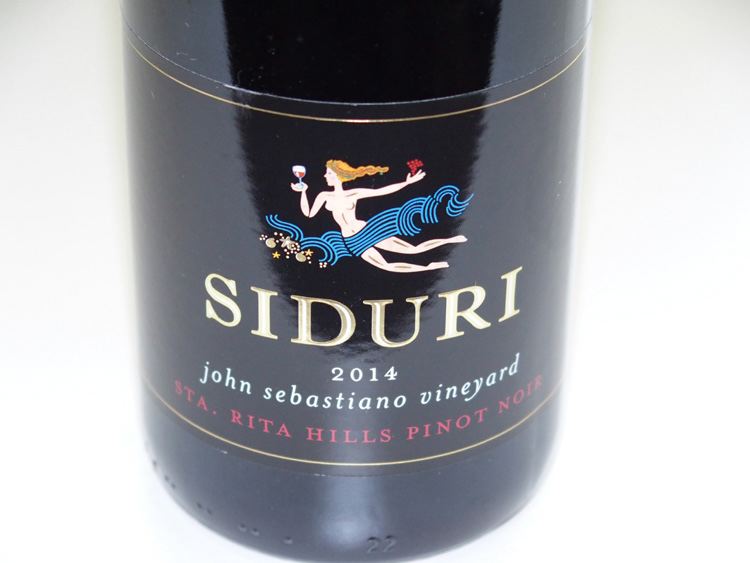 2014 Siduri John Sebastiano Vineyard Sta. Rita Hills Pinot Noir 14.1% alc., pH 3.54, TA 0.68, 181 cases, $55, screwcap. Release November 16, 2016. · Moderately dark reddish purple color in the glass. I have had consistently fine wines from this vineyard and this bottling is no exception. Well-perfumed with aromas of boysenberry, blackberry and balsam. Delicious mid weight plus purple berry melange coats the tongue, progressing to a notably long and intense finish. Very special, with welcome oak and spice nuances and impeccable balance. I really liked this wine. Score: 93
2014 Siduri Soberanes Vineyard Santa Lucia Highlands Pinot Noir 14.4% alc., pH 3.61, TA 0.64, 144 cases, $50, screwcap. Release November 16, 2016. · Moderate reddish purple color in the glass. Glorious fruit is on display in this wine with aromas of blackberry and blackest cherry replicated on the palate. Flavors of spice and dark chocolate chime in. Smoothly textured, with lacy tannins and a charge of fruit on the juicy finish that leaves a hint of warmth in its wake. Score: 91
2015 Siduri Arbre Vert Vineyard Willamette Valley Pinot Gris 293 cases, $29, screwcap. Release November 16, 2016. Vines planted in the 1980s, own-rooted vines. Aged in a combination of stainless steel and older French oak barrels. No malolactic fermentation. · Moderate golden yellow color and clear in the glass. Flinty, struck match aromas accompany scents of peach, dried herbs and almond. Somewhat exotic, with flavors of peach, apricot, apple brown butter and brioche. Nicely balanced with an easygoing vibe. Score: 87
Three Sticks Winery, Santa RosaBob Cabral, formerly the winemaker at Williams Selyem, has been leading the team at Three Sticks for the past 18 months. He is a fourth-generation farmer and grower from the San Joaquin Valley, he grew up pruning vines and harvesting grapes on his family’s 70-acre ranch near Escalon. He then spent 17 vintages as head winemaker at Williams Selyem. Currently, he works with associate winemakers Ryan Prichard and Ashley Holland. Tours and tastings of Three Sticks wines are available by reservation Monday through Saturday at Sonoma’s Adobe, a historic villa constructed in 1842 and now the longest occupied home in Sonoma. Both focused tastings and food and wine experiences are offered. 707-996-3328. The website is www.threestickswines.com. These two Pinot Noirs are single vineyard designates from the winery’s two “home” vineyards.
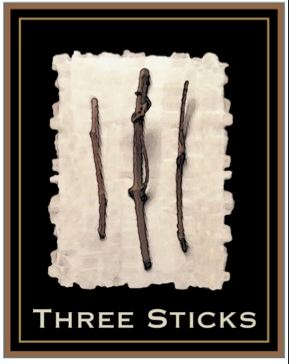
2014 Three Sticks Durell Vineyard Sonoma Coast Pinot Noir 14.1% alc., pH 3.50, TA 0.62, 352 cases, $65. 30% whole cluster. Aged 15 months in French oak barrels, 60% new. · Moderately dark reddish purple color in the glass. The nose is highly engaging with aromas of cherry, raspberry, earthy mushroom, cinnamon spice and slightly charred oak picking up intensity over time in the glass. The middleweight flavors of black cherry, dark raspberry and blueberry are expansive and nicely accented with spice and oak. Plenty of charm and elegance with a silky mouthfeel, good vibrancy and welcome finishing power. This wine really blossomed later in the day when re-tasted from an opened and recorked bottle. Score: 94
2014 Three Sticks Gap’s Crown Vineyard Sonoma Coast Pinot Noir 14.5% alc., pH 3.50, TA 0.59, 354 cases, $65. This vineyard is an Estate property of Three Sticks located in the Petaluma Gap. 13% whole cluster, aged 15 months in French oak barrels, 60% new. · Moderate reddish purple color in the glass. Demonstrative aromas of cherry pie, baking spices and toasty oak combine for an inviting experience. Highly appealing black cherry fruited core is framed by juicy acidity and modest tannins. A dancing, stylish wine with good finesse, plenty of sap, and a persistent finish. Score: 93
Wonderment Wines, Napa
2014 Wonderment Dutton-Campbell Vineyard Green Valley of Russian River Valley Pinot Noir 14.1% alc., 264 cases, $40. · Light cherry color in the glass. This wine is currently sporting some oak swagger which should integrate further with time in bottle. Aromas of cherry, cranberry, cola and baking spices are heady. Elegantly composed and easy to like with mid weight flavors of cherry, raspberry, and oak spice. The tannins are buried, the spry acidity invigorates the wine and the raspberry coulis finish satisfies. Score: 91
2014 Wonderment Dr. Stan’s Vineyard Sonoma Carneros Pinot Noir 14.4% alc., 74 cases, $50. Dijon clone 115. · Moderately light reddish purple color in the glass. Immensely charming nose with hi-tone aromas of cherry, red berry, red hard candy and sandalwood. Stylistically similar to the Dutton-Campbell bottling with a sleek and elegant demeanor but with better oak integration. The flavors of red cherry and berry are framed by delicate tannins and sound acidity. A red-fruited joy. Score: 92
Recently Tasted Chardonnay
2014 FEL Savoy Vineyard Anderson Valley Chardonnay 14.5% alc., $48. · Moderate golden yellow color in the glass. Highly engaging aromas of lemon curd, Golden Delicious apple, buttery brioche, crème brûlée and a touch of spice. Delicious flavors of lemon, pineapple, pear, spice and caramel are complimented by crisp acidity in a bold quintessential California style barrel fermented Chardonnay that offers both abundant fruit flavor as well as quenching vibrancy. Score: 94
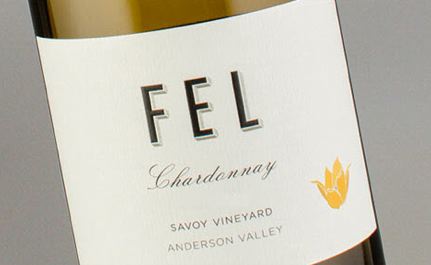
2014 Frank Family Vineyards Carneros Chardonnay 14.5% alc., pH 3.46, TA 0.61, 25,000 cases, $35. The foundation of this wine is the Frank Family’s Lewis Vineyard in Napa Carneros. Other fruit sources include Beckstoffer Vineyards and Hudson Vineyards in Napa Carneros and Sangiacomo Vineyards in Sonoma Carneros. Barrel fermented and aged with lees stirring for 9 months in French oak barrels, 34% new. · Moderately light golden yellow color in the glass. Nicely perfumed with aromas of petrichor, apple, pear, white peach, straw and vanilla. Crisp and fresh on the palate, with apple-focused flavor and very little oak overlay. Score: 89
2014 Frank Family Vineyards Lewis Vineyard Reserve Carneros Chardonnay 14.5% alc., pH 3.26, TA 0.61, 1,000 cases, $65. Dijon clones. Aged 11 months in 100% new French oak barrels. · Moderately light golden yellow color in the glass. More oak influence in this reserve wine, but it is not overbearing. Aromas of apple, lemon curd and spice gather intensity over time in the glass. Refined, seamless and sophisticated, with a tasty melange of citrus, apple, tropical fruit and spice flavors and beautifully integrated oak accents. A classy wine that has all the best features of barrel fermentation. Score: 94
2015 Kingston Family Vineyards Sabino Casablanca Chile Chardonnay 12.5% alc., 110 cases, $26, screwcap. Indigenous yeast fermentation. Aged 10 months in French oak barrels including some large format barrels and egg-shaped concrete tanks. · Moderate golden yellow color and clear in the glass. Shy aromas of pungent herbs, moss, lemon cream and a hint of toasty oak. Crisp and bright in a mildly austere style with flavors of lemon-lime and grapefruit, a slightly viscous texture, with good balance and a refreshing finish. Tasted several hours later, the wine was unchanged. Score: 88
2015 Loring Wine Company Rosella’s Vineyard Santa Lucia Highlands Chardonnay 14.5% alc., pH 3.44, 100 cases, $44, screwcap. Released September 2016. · Moderately light golden yellow color in the glass. Aromas of lemon wafer, white orchard fruits and flint lead off in this appealing wine with alluring flavors of lemon, pineapple, yellow apple and brioche. Slightly creamy in the mouth, with a deft touch of oak and an uplifting, juicy finish. Score: 90
2015 Loring Wine Company Sierra Mar Vineyard Santa Lucia Highlands Chardonnay 14.3% alc., pH 3.47, 100 cases, screwcap, $44. Release February 2017. · Moderately light golden yellow color in the glass. Aromas of white stone fruits, lemon oil, caramelized popcorn and grilled banana. Silky in the mouth with somewhat restrained and well-ripened fruit flavors of nectarine, pineapple and burnt lemon with toasty oak in the background, a supportive acid framework and a lip-smacking finish. This wine will appeal to fans of well-oaked Chardonnay. Score: 87
2014 Peake Ranch Sierra Madre Vineyard Santa Maria Valley Chardonnay 14.3% alc., 327 cases, $40. · Moderately light golden yellow color in the glass. Demure aromas of citrus, tropical fruits, paraffin and subtle oak lead to flavors of pineapple, apple, grilled lemon, guava and charred oak in a slightly creamy style with well-integrated acidity. Score: 89
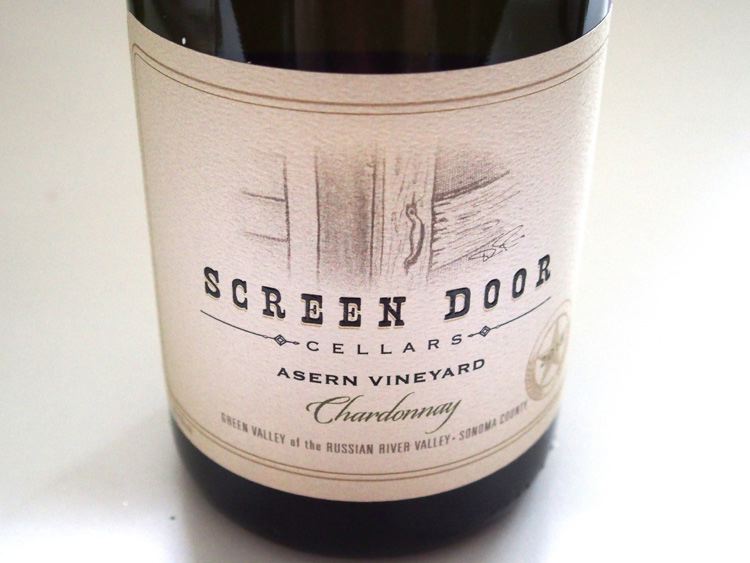 2015 Screen Door Cellars Asern Vineyard Green Valley of Russian River Valley Chardonnay 14.2% alc., $25. Inaugural release. · Moderately light golden yellow color in the glass. Complex aromatic pleasure including scents of lemongrass, green apple, peach skin, dried herbs and chalk dust. Flavors of lemon, pear, Gravenstein apple and buttery brioche fan out on the palate and hold court through a tight, lemony finish. Crisp, even slightly steely, with icy Green Valley acidity elevating the fruit flavors. Score: 93
2014 Three Sticks Durell Vineyard Sonoma Valley Chardonnay 14.6% alc., $50. · Moderately light golden yellow color and crystal clear in the glass. Generous oak overlay intercedes in this wine with aromas of baked apple, toast, oak spice, buttery brioche and nuts, and bold flavors of pineapple, lemon, vanilla, caramel and toast. Slightly creamy on the palate, with integrated acidity and some lingering oak-kissed fruit on the finish. Score: 88
Pinot BriefsFreixenet USA Launches WindVane Luxury Wines Freixenet USA, the owners of Gloria Ferrer Caves & Vineyards, announced the release of the first wine from its new luxury wine brand, WindVane, an homage to the wind that lends to the unique character of the wines of western Carneros. The 2014 WindVane Carneros Reserve Pinot Noir ($80) is the first release, a blend of Pinot Noir grapes from some of the windiest and most devigorated vineyard blocks located throughout the 335-acre estate vineyards of Gloria Ferrer in the Carneros AVA. Only 100 cases have been produced under the direction of Steven Urberg, who leads the winemaking for Gloria Ferrer. This wine will be available in select accounts in California and New York. In 2017, approximately 3,000 cases of WindVane Estate Grown Pinot Noir and Chardonnay will be released nationally. Visit www.windvanewines.com.
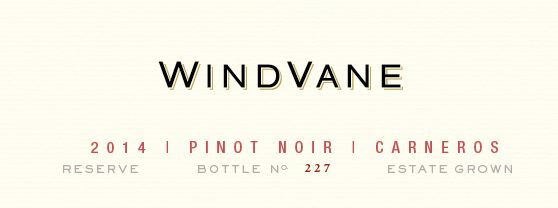 How to Drink Like a Billionaire: Mastering Wine with Joie de Vivre Wine expert and personality Mark Oldman expounds on the secrets of the wine world in this witty guide, advising the reader how to drink like a billionaire on a small budget. In 132 short chapters, Oldman peels away the pretension that surrounds wine and offers straight talk on finding moderately priced bottles that drink like expensive ones, avoid being a victim of wine trends, insider wine lingo, and how to deal with wine lists and sommeliers. Hardcover, $17.50 through major retailers. Reviewers have raved about this book.
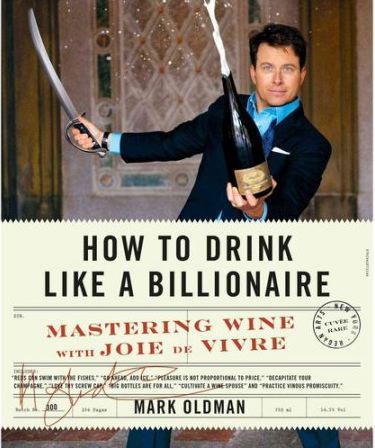 Spring Mountain District Harvest Celebration 18 wineries from Napa Valley’s Spring Mountain District will be hosting a tasting of current releases along with a few surprise vintages. The event will be held Thursday, November 17, 2016, from 5:00 p.m. to 8:00 p.m. at the Presidio Golden Gate Club in San Francisco. Tickets ($65) can be bought at Eventbrite. Participating wineries include Barnett Vineyards, Keenan Winery, School House Vineyard, Smith-Madrone and Stony Hill Vineyard. Plum: An Innovative Wine Accessory Plum is a fully automated appliance that allows one to open a bottle of red or white wine, pour a temperature controlled pour, and preserve the remaining wine, all at the touch of a button. A needle pierces the bottles closure, dispenses the wine, and pressurizes the bottle with argon gas. The wine is said to be preserved for 90 days. Designer David Koretz, who has a long history in the tech industry, wanted a device that would allow him to have a glass of wine at the end of the day available easily at the proper temperature. In addition, a computer and camera is integrated into the Plum, allowing scanning to identify the wine vintage, varietal, region and winery from a database of more than six million wines and the result appears on a touchscreen. Astonishingly, Plum works with any standard 750 ml bottle of wine with any closure, including artificial cork and even metal screw caps. Two bottles are nestled in separate cooling chambers that can be kept at different serving temperatures. Plum can be pre-ordered now for shipping in spring 2017. $1499. Visit https://shop.plum.wine/products/plum?variant=27127742403.
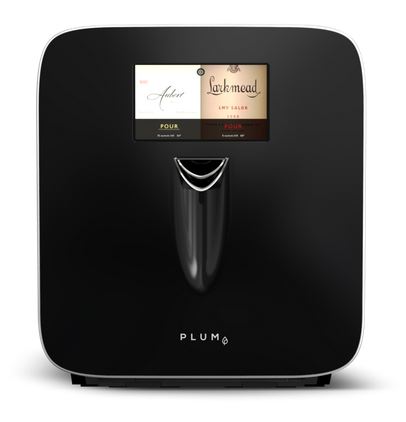 Vertical: Passion and Pinot on the Oregon Wine Trail This recently released book by Rex Pickett is a sequel to the book Sideways. Pickett follows the friendship of Miles and Jack as they drive and drink their way through the Willamette Valley. Originally released as Vertical in 2011 in a self-published, small press run, this new release has been re-titled and reedited for wide distribution and illustrated with New Yorker style chapter headings and vignettes. In this novel, Miles and Jack along with Miles’s wheelchair-bound mom, her dog, and her pot-smoking caretaker, heading to Sheboygan, Wisconsin, where his mother will live out her last days with her sister. First, Miles has a date as the honorary emcee of the International Pinot Noir Festival. For more information, visit ww.w.LooseGravelPress.com
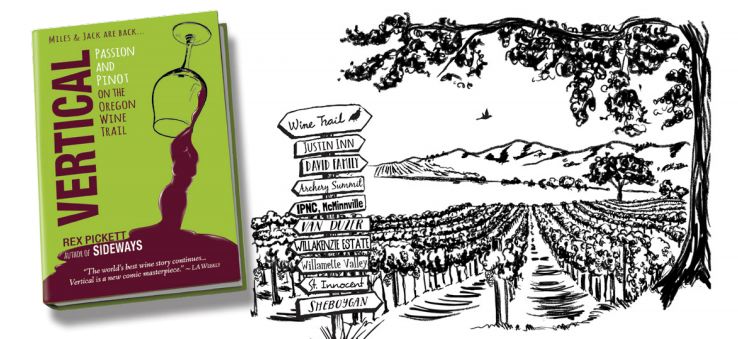 Rare DRC Wines Command Stratospheric Prices At the recent Christie’s Fine Wines and Spirits Auction, six bottles of 1978 Romanée-Conti burgundy sold for $110,000, or about $18,000 per bottle. The price doesn’t include the 25% buyer’s premium added to the hammer price. Two bottles of 1978 Romanée- Conte Le Tache sold for $22,000, and six bottles of 1976 Romanée-Conti Richebourg sold for $11,000. The wines were from the collection of the late executive Jay Stein. Oregon Harvest Report 2016 This was another easy vintage for Oregon vintners, with most grapes picked by the first week in October. Despite the early harvest, the growing season was still lengthy because of early flowering in the spring. Vintage 2016 was the third in a string of ideal vintages with no weather pressure. California’s North Coast Enjoys Ideal 2016 Growing Season The weather leading up to harvest was ideal in 2016 except for a light rain the week of October 3 that did not cause any significant problems. Like Oregon, Pinot Noir harvest was essentially over by the end of the first week of October. Yields were average or better and quality was superb. Rainfall was adequate, with most of it coming in late winter and early spring. Harvest began early in the third week of August. That is not to say there no challenges for powdery mildew was evident and the vine mealybug, that can transmit grapevine leafroll viruses, was prevalent. California regional tonnage totals:
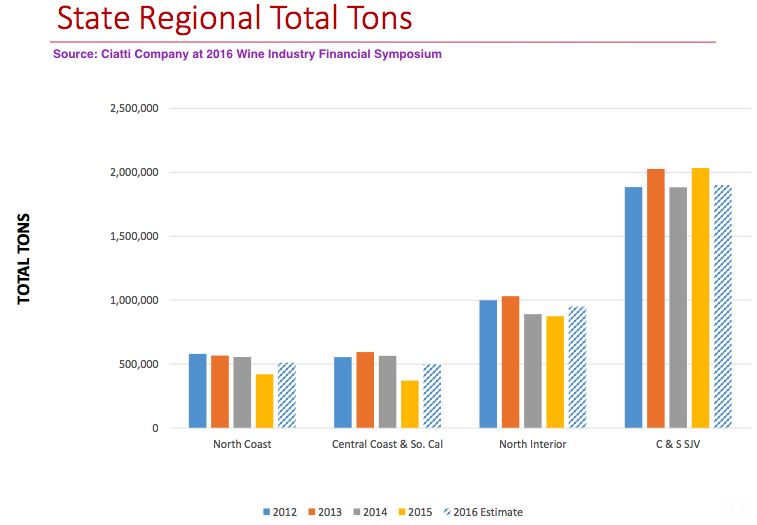
|